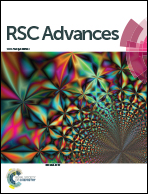Fe3O4 and paclitaxel loaded emulsion with charge-conversional surface for tumor MRI and therapy
Abstract
In this study, Fe3O4 magnetic nanoparticles and paclitaxel loaded oil in water emulsion was fabricated for tumor-targeted chemotherapy, MRI and near-infrared photothermal therapy. An amphiphilic glycol chitosan–cholic acid conjugate (GCCA) was synthesized by an amidation reaction and a bovine serum albumin–dextran conjugate (BD) was produced by the Maillard reaction. The BD/GCCA electrostatic complex was used as a complex emulsifier to produce Fe3O4 and paclitaxel loaded emulsion by high pressure homogenization. The emulsion possesses an average droplet size of about 250 nm and a transversal R2 relaxation rate of 326 mM−1 s−1. The droplets are stable at physiological conditions due to the dextran and glycol chitosan surface. The droplet surfaces are negatively charged at pH 7.4 and positively charged at pH 6.5. The droplets can be effectively accumulated at the tumor site by attaching a small magnet to the tumor and the pH sensitive charge-conversional surfaces may promote the tumorous cellular uptake of the droplets. In vivo investigations verified that the emulsion, administrated via the tail vein and guided by an external magnetic field, significantly enhanced the anti-tumor efficacy and reduced the toxicity of paclitaxel as well as improved the tumor contrast effect in T2-weighted MRI. More importantly, after intratumoral injection of the emulsion and near-infrared laser irradiation, H22 solid tumors were completely eliminated.


 Please wait while we load your content...
Please wait while we load your content...